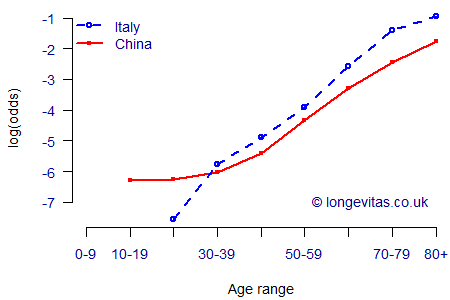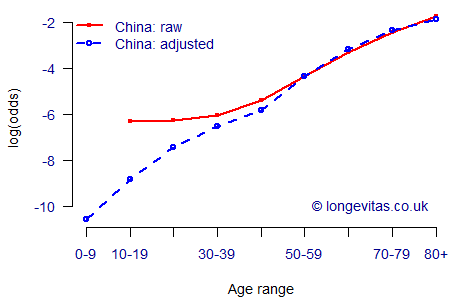COVID-19 mortality and age
When faced with a pandemic disease, such as the ongoing Covid-19 crisis, a multi-layered approach is useful. From an individual perspective, there is a strong analogy with the computing-security concept of defence in depth (see Gavin's blogs on this subject): social distancing reduces your exposure to the virus in the first instance, and hand-washing stops the virus particles you do get from going further. But what happens when the various counter-measures fail and someone finally catches the virus? Specifically, what is the mortality rate?
It is tricky to estimate mortality rates during a pandemic. Part of the problem lies in the numerator: with co-morbidities it is not always clear what the actual cause of death is. A bigger problem lies in the denominator: with indications that some infected persons experience minor or no symptoms, there is scope for under-estimating the denominator and thus over-estimating the mortality rate. A further problem is temporal: today's deaths are of people infected at least a fortnight previously, which can lead to under-estimation of the mortality rate with a rapidly growing infected population.
Nevertheless, one of the most prominent risk factors for Covid-19 seem proven: age. Figure 1 shows the log-odds ratio for two countries with large numbers of fatalities.
Figure 1. Log-odds ratio for mortality of confirmed cases of Covid-19 by age. Source: own calculations using data from ISS (2020) and The Novel Coronavirus Pneumonia Emergency Response Epidemiology Team (2020).

The two countries' data don't quite agree on the mortality levels, but they do agree on the stark progression with age. Perhaps the most striking aspect of Figure 1 is the very low mortality rate for those under 30: of the 5,185 confirmed Covid-19 cases in Italy there were just two deaths (and none under the age of 20, hence the absence of log-odds ratios for young age groups). In China there were just eight deaths out of 4,584 cases among the under-30s, a mortality rate of just 1.7 per thousand.
The very low death rates for younger people suggest a much less severe reaction to the infection. Indeed, a less severe reaction might lead to cases not being diagnosed at all. One question is how mortality rates might look after adjusting for "censoring, demography, and underascertainment", as attempted by Verity et al (2020) using the same data from China. The raw and adjusted log-odds ratios are shown in Figure 2.
Figure 2. Log-odds ratio for mortality of confirmed cases of Covid-19 in China by age. Source: own calculations using data from Verity et al (2020, Table 1).

The progression with age in Figures 1 & 2 is perhaps what one would expect for a novel viral infection, although the same was not true in the Spanish Influenza pandemic a century ago. That historical epidemic also harbours a warning for those under-30s who think that Figure 1 means they don't need to worry about Covid-19. There is circumstantial evidence that survivors of the Spanish Influenza pandemic went on to suffer an epidemic of coronary heart disease in later life. While Figures 1 & 2 show that there is little short-term risk for the young, there is no way of predicting how Covid-19 may affect their future mortality. The current health advice therefore applies to everyone regardless of age: keep your distance and wash your hands.
References:
Istituto Superiore di Sanità (ISS) (2020) Epidemia COVID-19, Aggiornamento nazionale, Istituto Superiore di Sanità, Rome, 30th March 2020.
The Novel Coronavirus Pneumonia Emergency Response Epidemiology Team (2020) The Epidemiological Characteristics of an Outbreak of 2019 Novel Coronavirus Diseases (COVID-19) — China, 2020, China CDC Weekly, 2020, 2(8), 113–122.
Verity, R., Okell, L. C., Dorigatti, I., Winskill, P., Whittaker, C., Imai, N., Cuomo-Dannenburg, G., Thompson, H., Walker, P. G. T., Fu, H., Dighe, A., Griffin, J. T., Baguelin, M., Bhatia, S., Boonyasiri, A., Cori, A., Cucunubá, Z., FitzJohn, R., Gaythorpe, K., Green, W., Hamlet, A., Hinsley, W., Laydon, D., Nedjati-Gilani, G., Riley, S., van Elsland, S., Volz, E., Wang, H., Wang, Y., Xi, X., Donnelly, C. A., Ghani, A. C., Ferguson, N. M. (2020) Estimates of the severity of coronavirus disease 2019: a model-based analysis, Lancet Infectious Diseases, DOSI: https://doi.org/10.1016/S1473-3099(20)30243-7.
Previous posts
Another look at the Gompertz model
The year 1825 was a significant one not only for actuaries but for the wider scientific community: Benjamin Gompertz published his landmark paper on the graduation of human mortality (Gompertz, 1825). There were at least three completely new ideas in his paper. First, he gave his famous law of mortality. To quote Gompertz:


Add new comment